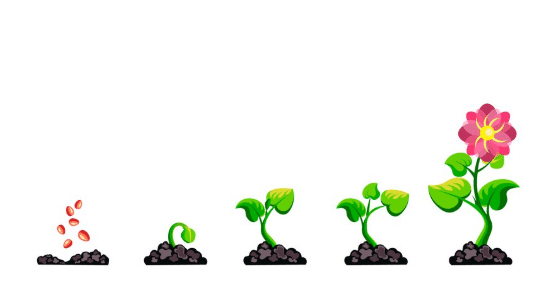Plants are the backbone of life on Earth, providing oxygen, food, and beauty to our environment. The plant life cycle is a fascinating process that outlines how a plant grows from a tiny seed to a mature organism capable of reproducing. We explores each stage of the plant life cycle in simple, engaging language to help gardeners, students, and nature enthusiasts understand how plants thrive. With a focus on clarity and authenticity, this article dives deep into the stages of plant growth, ensuring a user-friendly and SEO-optimized experience.
Understanding the Plant Life Cycle
The plant life cycle describes the stages a plant undergoes from seed to reproduction and, in some cases, death. Every plant follows a similar path, though the duration and specifics vary by species. Annual plants complete their cycle within a single growing season, while biennials take two years, and perennials live for many years, repeating parts of the cycle. This journey involves distinct phases, each critical to the plant’s survival and reproduction.
Stage 1. Seed Germination
The plant life cycle begins with seed germination, where a dormant seed awakens to start a new plant. A seed contains an embryo, a tiny plant waiting to grow, along with stored food to fuel its early development. For germination to occur, the seed requires water, oxygen, and the right temperature. Some seeds also need specific light conditions to sprout. When water soaks into the seed, it swells, causing the seed coat to split. A small root, known as the radicle, emerges and grows downward to anchor the plant and absorb nutrients. Meanwhile, a shoot stretches upward, seeking sunlight. This delicate process marks the start of a plant’s life and sets the foundation for its growth.
Stage 2. Seedling Development
Once germination occurs, the plant enters the seedling stage. At this point, the young plant develops its first leaves, called cotyledons, which help it produce energy through photosynthesis. Photosynthesis is the process where plants use sunlight, carbon dioxide, and water to create food. Seedlings are fragile and depend on the seed’s stored nutrients until they can sustain themselves. During this stage, the plant grows true leaves, which resemble the leaves of the mature plant, and its root system expands to draw in water and nutrients. Proper care, including adequate water and light, is essential to help seedlings grow strong and healthy.
Conditions for Healthy Seedlings
Seedlings need specific conditions to thrive. Consistent moisture keeps them hydrated, but overwatering can cause root rot. Sunlight or artificial grow lights provide the energy needed for photosynthesis. Nutrient-rich soil supports their growth, giving them the strength to transition to the next stage. Protecting seedlings from pests and extreme weather is also crucial for their survival.
Stage 3. Vegetative Growth
After the seedling stage, the plant enters vegetative growth, a phase focused on building size and strength. The roots grow deeper and spread wider to absorb more water and nutrients from the soil. The stem thickens and elongates, supporting the plant’s structure. Leaves multiply, increasing the plant’s ability to photosynthesize and store energy. This stage varies in length depending on the plant type. For instance, annuals like zinnias move through this phase quickly, while trees and perennials, such as oak trees or roses, take much longer. During vegetative growth, the plant prepares for reproduction by developing the structures needed for the next stages.
Stage 4. Flowering
When the plant reaches maturity, it begins to produce flowers, the reproductive organs of the plant. Flowers attract pollinators like bees, butterflies, and birds with their vibrant colors and sweet scents. Some plants, like grasses, rely on wind for pollination and have less noticeable flowers. Inside a flower, the male part, called the stamen, produces pollen, while the female part, known as the pistil, houses the ovary where seeds will form. The flowering stage is critical because it leads to the production of seeds, ensuring the plant’s survival. The timing of flowering depends on the plant’s type, with annuals blooming in one season and perennials flowering multiple times over years.
Types of Flowering Plants
Different plants follow unique patterns in their flowering stage. Annual plants, such as marigolds, bloom and produce seeds within a single season. Biennials, like carrots, grow leaves and roots in the first year and flower in the second. Perennials, such as lavender, bloom repeatedly over many years, adding beauty to gardens season after season.
Stage 5. Pollination
Pollination is the process that enables plants to reproduce. It occurs when pollen from the stamen reaches the pistil, fertilizing the ovules inside the ovary. This can happen through self-pollination, where pollen moves within the same flower or plant, or cross-pollination, where pollen transfers between different plants, often with the help of pollinators. Bees, butterflies, and other insects play a vital role in cross-pollination, while wind and water can also carry pollen for certain plants. Successful pollination is essential for producing fruits and seeds, which are critical for both plant reproduction and human food production.
Stage 6. Seed Production and Dispersal
After pollination, the ovary develops into a fruit or seed pod, and the ovules inside become seeds. For example, in a sunflower, the flower head transforms into a collection of seeds, while in a pea plant, the ovary becomes a pod containing peas. The fruit or pod protects the seeds and aids in their dispersal. Seeds spread in various ways, ensuring the plant’s offspring reach new locations to grow. This marks the completion of the plant life cycle, as the new seeds are ready to germinate and begin the process again.
Methods of Seed Dispersal
Seeds travel to new locations through several natural methods:
-
Wind carries lightweight seeds, like those of dandelions, across long distances.
-
Animals eat fruits and spread seeds through their droppings, as seen with berries.
-
Water transports seeds in plants near rivers or oceans.
-
Humans plant seeds intentionally in gardens or farms.
Factors Influencing the Plant Life Cycle
The plant life cycle is influenced by several environmental factors. Temperature and rainfall determine how quickly seeds germinate and grow. Nutrient-rich soil provides the essential minerals plants need to thrive. Adequate sunlight fuels photosynthesis, while water ensures plants stay hydrated. Pests and diseases can disrupt growth, so protecting plants is vital. By managing these factors, gardeners and farmers can help plants complete their life cycle successfully.
Why the Plant Life Cycle Matters
Understanding the plant life cycle has practical applications. For gardeners, it guides planting and care routines to ensure healthy growth. Farmers use this knowledge to optimize crop production, timing planting and harvesting for maximum yield. Students learn about biology and ecosystems through the plant life cycle, fostering a deeper connection to nature. Conservationists rely on this understanding to protect plant species and maintain biodiversity. By appreciating the plant life cycle, we can better support the plants that sustain our world.
Conclusion
The plant life cycle is a remarkable journey that transforms a small seed into a thriving plant capable of reproducing. From germination to seed dispersal, each stage—seedling development, vegetative growth, flowering, pollination, and seed production—plays a vital role in a plant’s survival. This cycle not only supports plant growth but also sustains ecosystems, agriculture, and human life. Whether you’re tending a garden, studying biology, or simply admiring nature, understanding the plant life cycle deepens your appreciation for the green world around us. By nurturing plants through each stage, we contribute to a healthier planet.







